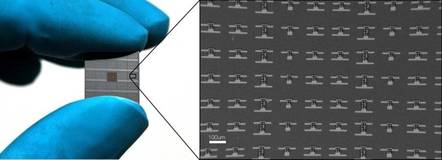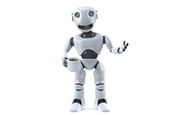This article is more than 1 year old
'It's like painting with atoms'... Watch how boffins form armies of simple micron-sized bots from a silicon wafer
And they may be injected into your body one day
Video Millions of tiny moving robots, each as small as the width of an average human hair, can be crafted from a four-inch silicon wafer, according to new research.
A team of eggheads at Cornell University presented their work at the American Physical Society Physics March Meeting in Boston this week. They described the laborious process of fabricating the teeny bots, each measuring ten to a hundred microns, over several years.
The process involves stacking glass, silicon, platinum, titanium, and other materials together to craft a four-inch wafer. Next, patterns are etched onto the wafer’s surface to create electrical circuits for solar cells to be carried by each mini machine. It takes a few weeks to fashion a million of them, and once their bodies are formed they can respond to light. The researchers shone a laser beam to send a current through the robots, causing their legs to bend into place. This only requires about 200 millivolts each.
"It's like painting with atoms," said Marc Miskin, an assistant professor of electrical and systems engineering at University of Pennsylvania who presented the talk. "The legs are super strong. Each robot carries a body that's 1,000 times thicker and weighs roughly 8,000 times more than each leg."
Here's a video [AVI] of them wriggling around, and a still pic below...
“The leg just twitched a bit. But it was the first proof of concept – this is going to work,” Miskin said. The robots aren’t really useful for anything yet, but Miskin and his colleagues hope that their small size means they can be used to deliver drugs or see inside the human body in the future.
“We found out you can inject them using a syringe and they survive. They're still intact and functional," he added.
Lasers can only control the robot from a distance equivalent to the width of a fingernail inside tissue. So if they were to be injected into people, another energy source is needed. The researchers hope the bots can also be powered by ultrasound or magnetic fields instead, in future.
"I think at its full potential, micro robots have a tremendous number applications. Right now, we're most excited about exploring the body with microrobots," Miskin told The Register.
"Microrobots give you a unique ability to gain access to parts of the body that would be difficult or dangerous to probe via macroscopic tools: for example, we're developing a project where you inject microrobots nearby a part of the body you want to explore, and they pilot themselves into tight spaces with minimal risk to the nearby tissue.
"What's unique about using robots in these applications is that they can do a lot of the complicated work for you: it can adapt itself, it can seek out the things you want to measure, it can look at its local environment and make decisions, and robots can do these things in parallel and automatically."
They are also working with another team of researchers in Pennsylvania to fit more complex components onto the robots’ bodies, such as controllers, sensors, and clocks.
"Outside the body, we're interested in designing robots to function as chemicals or materials. Here, robots will join together to function as material or locally guide chemical reactions based on onboard sensing and computation. For example, my group is in the early stages of developing robots that live inside lithium ion batteries and clean the surface to make them safer and last longer," he concluded. ®


